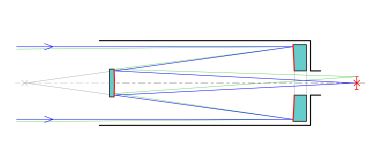Das Hauptteleskop der Hans-Haffner-Sternwarte ist der Astrograph CDK 20 der Firma PlaneWave-Instruments mit einem Hauptspiegeldurchmesser von 50 Zentimetern. Das Teleskop wird von einer GM 4000 HPS II-Montierung von 10Micron getragen und durch das apochromatische Linsenteleskop ED 120 von Sky-Watcher mit einer Öffnungsweite von 12 Zentimetern ergänzt.
Anders als in der Mikroskopie kommt es beim Teleskop nicht so sehr auf die Vergrößerung an. Vielmehr ist die Lichtsammelfläche eines Teleskops wissenschaftlich meist von größerer Bedeutung, weil viele astronomische Objekte von der Erde aus beobachtet äußerst lichtschwach erscheinen. Je größer der Durchmesser des Spiegels oder der Linse ist, desto heller erscheint das astronomische Objekt und desto mehr Details können erkannt werden.
So hat das CDK 20 im Vergleich zur menschlichen Pupille eine etwa zehntausendfach größere Lichtsammelfläche.
Ein Astrograph ist ein Teleskop, das für die Astrofotografie optimiert ist. Er erzeugt ein möglichst großes, abbildungsfehlerfreies und planes Bild, so dass der ebene Kamerachip möglichst gleichmäßig und verzeichnungsfrei bis zum Rand ausgeleuchtet wird.





